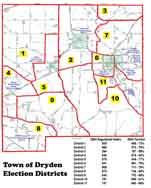Sustainable Energy
 Last night Supervisor Trumbull, three Town Board members (including myself), several members of the Planning Board and several members of the Conservation Council visited two residential wind energy installations in the Town of Caroline.
Last night Supervisor Trumbull, three Town Board members (including myself), several members of the Planning Board and several members of the Conservation Council visited two residential wind energy installations in the Town of Caroline.Questions about how wind energy converters look and sound were easily answered. This tower, at the home of Steve Nicholson, is about thirty-five feet tall. It blends with the surroundings so well that I had a hard time getting a picture that shows it clearly. It was drizzling while we were there and the sound of the rain on my umbrella masked the whooshing sound of the spinning blades. Nicholson says the 600W wind converter supplies nearly all his household electricity in the winter. Solar collectors provide the rest. Because the house is "off the grid," the energy is stored in batteries before reaching the house's conventional wiring. Nicholson acknowledges that if the tower were higher the converter would provide more electricity. In fact, he will soon have to cut some trees that have grown substantially since the tower was built ten years ago.

This tower at Ed Cope's house is more conspicuous since it's not surrounded by trees. The forty foot tower supports a 2kW converter with blades between seven and eight feet long. The wind was barely blowing while we were here. Cope says it is louder than the one at Nicholson's house.
Both Cope and Nicholson built their wind towers because their houses were far from enough from existing electrical lines to make connection prohibitively expensive. Both designed their systems for winter wind and supplemented the wind converters with solar collectors for summer energy. Cope has since connected to the electrical grid (sharing the cost with new neighbors) and is thus able to direct excess electricity generated by his system to the public utility.
My questions, as a Town Board member, were about safety and the visual and audible impact. The view from both of these sites is fabulous and the towers don't detract from it. They're barely audible. New research is showing that the impact on wildlife is minimal. The wind towers are constructed so as to be unlikely to fall and sited so that if they did fall the risk of damage to surrounding structures or injury to people is nearly non-existent. The solar collectors are silent, less visible than the towers and pose no safety risk at all that I'm aware of. From an ethical standpoint, how could the Town possibly rationalize preventing residents from building and using sustainable energy equipment? In fact, shouldn't we be actively promoting the development of sustainable energy?



0 Comments:
Post a Comment
<< Home